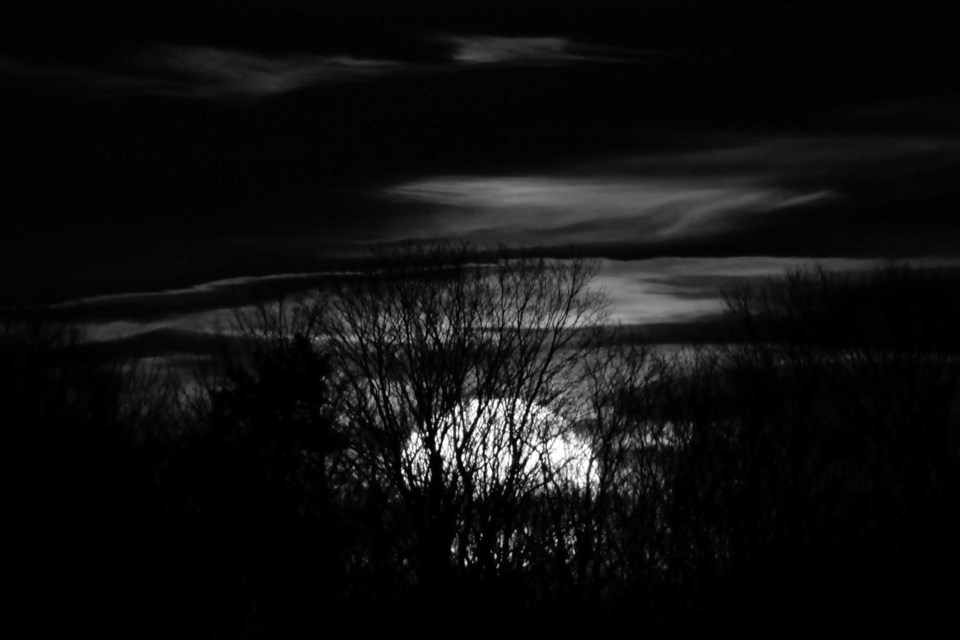A few evenings ago there appeared in the night sky a wonderfully lit half moon, surrounded by the sparkle and glint of thousands of stars.
While standing outside in the new fallen snow I immediately went back (in my memories) to a similar night years ago when I had been asked by a local resort to take their weekend guests on a wintertime evening hike.
The recreation staff had posted the event to start at 6:30 p.m. which was just after suppertime. The wind was picking up, and ice crystals caught in the ground drift were starting to sting exposed skin.
The temperature was a chilly minus 20 degrees, and beyond the glow of the patio light it was dark -- very dark. All of which added up to being the perfect time to lead a night hike.
While waiting for participants to arrive, I wondered how many would actually take the risk to attend. After all, a full and hearty dinner would have had to be wolfed down in order to meet the start time. And a winter storm was sweeping in.
Standing alone on the front-door patio it was obvious that, yeah, you'd have to be a bit crazy to join in this event.
By the posted start time there was actually one person standing with me outside in the biting wind. Then a couple appeared, looking a bit apprehensive, as if maybe they'd prefer that I just cancel this event, giving them an excuse to correct their decision to show up. Then a family of four burst out the door, still eating dessert off a napkin.
A request came to please wait a moment, as others were still bundling up with layer upon layer of clothes. It took a few minutes, but when we finally started out the group numbered 28 slightly crazy people, including two slightly inebriated sports dudes who had gotten in line just because we were forming one.
The first stop on our hike was only on the other side of the parking lot, still under the glare of the overhead yard light, yet away from the door of safe retreat.
I explained that on this night hike there would be no flashlights used (although I had two along in case of emergency), and that we would rely on our own night vision to 'see' us along the path through the woods.
The children took a noticeable step closer to their parents; and the two drunks fell silent, perhaps realizing this wasn't a weird conga line after all.
While we were bunched up there I turned one of the flashlights on and pointed it at the ground. There seemed to be a calming charm to the yellowish glow.
With a dramatic flourish I turned the light off and tucked it deep inside a coat pocket. Although blinking with some anxiety, we turned our backs to the resort and headed towards the distant and very dark waiting forest. Despite my focused hoping and wishing, a coyote did not howl. Bummer.
The next stop was just inside the forest edge, where the illumination of the distant parking lot light still reached us, yet the quiet beauty of the snow-laden trees could start to be noticed.
Here they received an explanation of night vision, that awesome thing that our eyes do naturally yet is a process that is seldom given the opportunity to happen, as night lights surround us in the 'real world'.
Night vision is the ability to see in low light conditions. Many animals can do this, and we, also being animals, can do it too.
As the level of light diminishes, the irises of our eyes open wider to capture as much light as possible. Within our eyes, lining the inside of the eyeball, are thousands upon thousands of little bumps and ripples called rods and cones (remember those high school science classes?).
The cones act as receivers for coloured light, and the rods transmit to our brain basic patterns or shapes. At night, there is no colour (or very little) so the cones relax and the rods get a chance to do a little overtime work.
There are more rods located around the perimeter of the eyeball than are found directly at the back. This means that black and white shapes are seen a bit more clearly when you look slightly to the side of the object.
Not realizing this, you tend to 'jump' when peering into dark areas as objects which are right beside you suddenly appear within your brain prior to it 'seeing' what's directly ahead. Sounds complicated, and it is. But it is the magic which makes a night hike work.
Along the way, I stop the group from time to time to explain how wildlife are equipped with big ears and big eyes to survive out here, either to detect food or to escape predators which hunt at night. Owls, foxes, deer, mice, and of course wolves and bears are all topics of discussion.
Once we get over the fables associated with the last two species, the crowd visibly relaxes.
Towards the end of the winter trail, I gather the group and suddenly click on the flashlight. This same light that less than an hour ago gave us a sense of calm now clashed with our senses and seemed so very harsh and unwanted.
All too soon we are done. The parking lot light once again glares garishly into our eyes and night vision is lost as our irises close down a few notches. A glance back towards the forest shows it once again as a dark and fearful place… except to those who have been there. For we now knew that the night can be a truly wondrous time.
